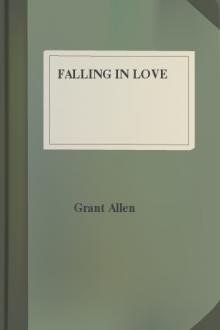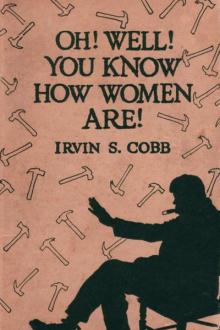Falling in Love by Grant Allen (different e readers .txt) 📕

- Author: Grant Allen
- Performer: -
Book online «Falling in Love by Grant Allen (different e readers .txt) 📕». Author Grant Allen
We went to Ogbury Barrows on an archæological expedition. And as the very name of archæology, owing to a serious misconception incidental to human nature, is enough to deter most people from taking any further interest in our proceedings when once we got there, I may as well begin by explaining, for the benefit of those who have never been to one, the method and manner of an archæological outing.
The first thing you have to do is to catch your secretary. The genuine secretary is born, not made; and therefore you have got to catch him, not to appoint him. Appointing a secretary is pure vanity and vexation of spirit; you must find the right man made ready to your hand; and when you have found him you will soon see that he slips into the onerous duties of the secretariat as if to the manner born, by pure instinct. The perfect secretary is an urbane old gentleman of mature years and portly bearing, a dignified representative of British archæology, with plenty of money and plenty of leisure, possessing a heaven-born genius for organisation, and utterly unhampered by any foolish views of his own about archæological research or any other kindred subject. The secretary who archæologises is lost. His business is not to discourse of early English windows or of palæolithic hatchets, of buried villas or of Plantagenet pedigrees, of Roman tile-work or of dolichocephalic skulls, but to provide abundant brakes, drags, and carriages, to take care that the owners of castles and baronial residences throw them open (with lunch provided) to the ardent student of British antiquities, to see that all the old ladies have somebody to talk to, and all the young ones somebody to flirt with, and generally to superintend the morals, happiness, and personal comfort of some fifty assorted scientific enthusiasts. The secretary who diverges from these his proper and elevated functions into trivial and puerile disquisitions upon the antiquity of man (when he ought rather to be admiring the juvenility of woman), or the precise date of the Anglo-Saxon conquest (when he should by rights be concentrating the whole force of his massive intellect upon the arduous task of arranging for dinner), proves himself at once unworthy of his high position, and should forthwith be deposed from the secretariat by public acclamation.
Having once entrapped your perfect secretary, you set him busily to work beforehand to make all the arrangements for your expected excursion, the archæologists generally cordially recognising the important principle that he pays all the expenses he incurs out of his own pocket, and drives splendid bargains on their account with hotel-keepers, coachmen, railway companies, and others to feed, lodge, supply, and convey them at fabulously low prices throughout the whole expedition. You also understand that the secretary will call upon everybody in the neighbourhood you propose to visit, induce the rectors to throw open their churches, square the housekeepers of absentee dukes, and beard the owners of Elizabethan mansions in their own dens. These little preliminaries being amicably settled, you get together your archæologists and set out upon your intended tour.
An archæologist, it should be further premised, has no necessary personal connection with archæology in any way. He (or she) is a human being, of assorted origin, age, and sex, known as an archæologist then and there on no other ground than the possession of a ticket (price half-a-guinea) for that particular archæological meeting. Who would not be a man (or woman) of science on such easy and unexacting terms? Most archæologists within my own private experience, indeed, are ladies of various ages, many of them elderly, but many more young and pretty, whose views about the styles of English architecture or the exact distinction between Durotriges and Damnonians are of the vaguest and most shadowy possible description. You all drive in brakes together to the various points of interest in the surrounding country. When you arrive at a point of interest, somebody or other with a bad cold in his head reads a dull paper on its origin and nature, in which there is fortunately no subsequent examination. If you are burning to learn all about it, you put your hand up to your ear, and assume an attitude of profound attention. If you are not burning with the desire for information, you stroll off casually about the grounds and gardens with the prettiest and pleasantest among the archæological sisters, whose acquaintance you have made on the way thither. Sometimes it rains, and then you obtain an admirable chance of offering your neighbour the protection afforded by your brand-new silk umbrella. By-and-by the dull paper gets finished, and somebody who lives in an adjoining house volunteers to provide you with luncheon. Then you adjourn to the parish church, where an old gentleman of feeble eyesight reads a long and tedious account of all the persons whose monuments are or are not to be found upon the walls of that poky little building. Nobody listens to him; but everybody carries away a vague impression that some one or other, temp. Henry the Second, married Adeliza, daughter and heiress of Sir Ralph de Thingumbob, and had issue thirteen stalwart sons and twenty-seven beautiful daughters, each founders of a noble family with a correspondingly varied pedigree. Finally, you take tea and ices upon somebody's lawn, by special invitation, and drive home, not without much laughter, in the cool of the evening to an excellent table d'hôte dinner at the marvellously cheap hotel, presided over by the ever-smiling and urbane secretary. That is what we mean nowadays by being a member of an archæological association.
It was on just such a pleasant excursion that we all went to Ogbury Barrows. I was overflowing, myself, with bottled-up information on the subject of those two prehistoric tumuli; for Ogbury Barrows have been the hobby of my lifetime; but I didn't read a paper upon their origin and meaning, first, because the secretary very happily forgot to ask me, and secondly, because I was much better employed in psychological research into the habits and manners of an extremely pretty pink-and-white archæologist who stood beside me. Instead, therefore, of boring her and my other companions with all my accumulated store of information about Ogbury Barrows, I locked it up securely in my own bosom, with the fell design of finally venting it all at once in one vast flood upon the present article.
Ogbury Barrows, I would have said (had it not been for the praiseworthy negligence of our esteemed secretary), stand upon the very verge of a great chalk-down, overlooking a broad and fertile belt of valley, whose slopes are terraced in the quaintest fashion with long parallel lines of obviously human and industrial origin. The terracing must have been done a very long time ago indeed, for it is a device for collecting enough soil on a chalky hillside to grow corn in. Now, nobody ever tried to grow corn on open chalk-downs in any civilised period of history until the present century, because the downs are so much more naturally adapted for sheep-walks that the attempt to turn them into waving cornfields would never occur to anybody on earth except a barbarian or an advanced agriculturist. But when Ogbury Downs were originally terraced, I don't doubt that the primitive system of universal tribal warfare still existed everywhere in Britain. This system is aptly summed up in the familiar modern Black Country formula, 'Yon's a stranger. 'Eave 'arf a brick at him.' Each tribe was then perpetually at war with every other tribe on either side of it: a simple plan which rendered foreign tariffs quite unnecessary, and most effectually protected home industries. The consequence was, each district had to produce for its own tribe all the necessaries of life, however ill-adapted by nature for their due production: because traffic and barter did not yet exist, and the only form ever assumed by import trade was that of raiding on your neighbours' territories, and bringing back with you whatever you could lay hands on. So the people of the chalky Ogbury valley had perforce to grow corn for themselves, whether nature would or nature wouldn't; and, in order to grow it under such very unfavourable circumstances of soil and climate, they terraced off the entire hillside, by catching the silt as it washed slowly down, and keeping it in place by artificial barriers.
On the top of the down, overlooking this curious vale of prehistoric terraces, rise the twin heights of Ogbury Barrows, familiar landmarks to all the country side around for many miles. One of them is a tall, circular mound or tumulus surrounded by a deep and well-marked trench: the other, which stands a little on one side, is long and narrow, shaped exactly like a modern grave, but of comparatively gigantic and colossal proportions. Even the little children of Ogbury village have noticed its close resemblance of shape and outline to the grassy hillocks in their own churchyard, and whisper to one another when they play upon its summit that a great giant in golden armour lies buried in a stone vault underneath. But if only they knew the real truth, they would say instead that that big, ungainly, overgrown grave covers the remains of a short, squat, dwarfish chieftain, akin in shape and feature to the Lapps and Finns, and about as much unlike a giant as human nature could easily manage. It maybe regarded as a general truth of history that the greatest men don't by any means always get the biggest monument.
The archæologists in becoming prints who went with us to the top of Ogbury Barrows sagaciously surmised (with demonstrative parasol) that 'these mounds must have been made a very long time ago, indeed.' So in fact they were: but though they stand now so close together, and look so much like sisters and contemporaries, one is ages older than the other, and was already green and grass-grown with immemorial antiquity when the fresh earth of its neighbour tumulus was first thrown up by its side, above the buried urn of some long-forgotten Celtic warrior. Let us begin by considering the oldest first, and then pass on to its younger sister.
Ogbury Long Barrow is a very ancient monument indeed. Not, to be sure, one quarter so ancient as the days of the extremely old master who carved the mammoth on the fragments of his own tusk in the caves of the Dordogne, and concerning whom I have indited a discourse in an earlier portion of this volume: compared with that very antique personage, our long barrow on Ogbury hill-top may in fact be looked upon as almost modern. Still, when one isn't talking in geological language, ten or twenty thousand years may be fairly considered a very long time as time goes: and I have little doubt that from ten to twenty thousand years have passed since the short, squat chieftain aforesaid was first committed to his final resting-place in Ogbury Long Barrow. Two years since, we local archæologists—not in becoming prints this time—opened the barrow to see what was inside it. We found, as we expected, the 'stone vault' of the popular tradition, proving conclusively that some faint memory of the original interment had clung for all those long years around the grassy pile of that ancient tumulus. Its centre, in fact, was occupied by a sepulchral chamber built of big Sarsen stones from the surrounding hillsides; and in the midst of the house of death thus rudely constructed lay the mouldering skeleton of its original possessor—an old prehistoric Mongoloid chieftain. When I stood for the first moment within that primæval palace of the dead, never before entered by living man for a hundred centuries, I felt, I





Comments (0)